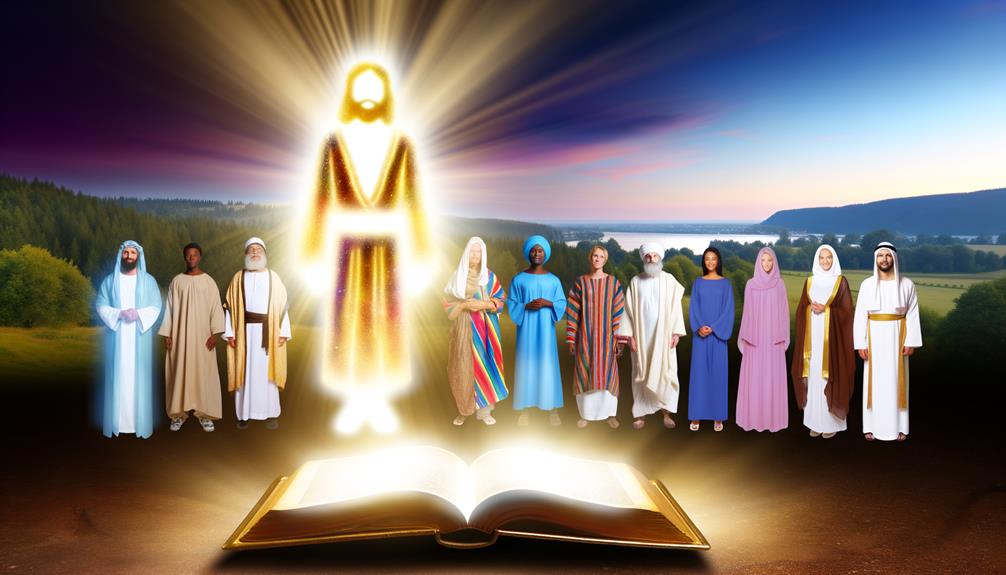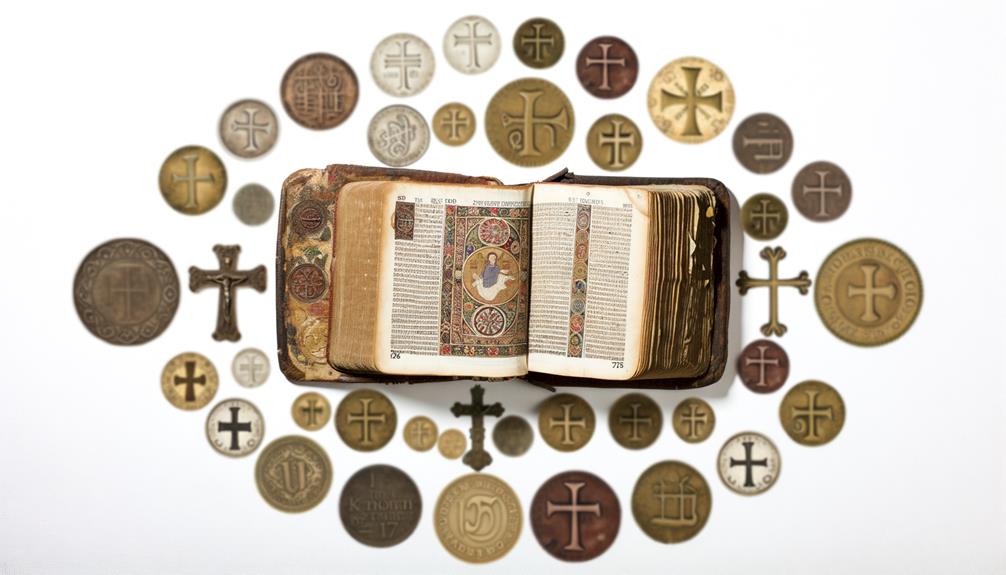144 000 Bible Verse Meaning: Revealed!
In the Book of Revelation, the 144,000 represent a group of individuals chosen by God, symbolizing divine selection and purity. Biblically originating from Revelation 7:1-8 and 14:1-5, they are depicted as being sealed from the twelve tribes of Israel, reflecting completeness and eschatological hope.
The number has sparked debates between literal and symbolic interpretations: some view it as a literal count of people from Israel, while others see it as symbolizing the universal, faithful remnant. Understanding its role within the apocalyptic narrative and differing theological perspectives can provide deeper insights into its significance.

Key Takeaways
- The 144,000 in Revelation symbolize completeness and divine selection from the twelve tribes of Israel.
- They represent a faithful remnant, characterized by purity and standing with the Lamb on Mount Zion.
- Interpretations vary, with some viewing it literally as a specific group and others symbolically as encompassing all of God’s people.
- Jehovah’s Witnesses believe the 144,000 are a literal group of anointed Christians with a special heavenly calling.
144,000 in the Bible: Symbolism, Meaning, and Key Verses
| Aspect | Explanation |
|---|---|
| Symbolism | Represents completeness and those sealed by God |
| 12 Tribes of Israel | 12,000 sealed from each of the 12 tribes of Israel |
| Spiritual Meaning | Represents spiritual Israel or faithful followers |
| Key Bible Verses | Revelation 7:4-8, Revelation 14:1-5 |
Biblical Origin of 144,000

The concept of the 144,000 originates from the Book of Revelation in the New Covenant, specifically mentioned in Revelation 7:1-8 and 14:1-5.
These passages describe 144,000 individuals from the twelve tribes of Israel, sealed by God to be protected from upcoming tribulations. The number signifies completeness and divine selection, often interpreted as representing a purified, faithful remnant.
Revelation 14:1-5 further depicts these individuals standing with the Lamb on Mount Zion, characterized by their purity and allegiance to God.
This figure has prompted extensive theological debate, with interpretations varying from literal to symbolic.
Contextually, the 144,000 can be seen as a metaphor for spiritual integrity and divine preservation amidst eschatological events.
The Book of Revelation

Exploring the Book of Revelation necessitates an understanding of its apocalyptic literature, rich symbolism, and profound theological messages. This final book of the New canon, attributed to John of Patmos, is a complex tapestry of visions and prophecies concerning the ultimate triumph of good over evil.
Revelation’s vivid imagery such as the Four Horsemen, the Beast, and the New Jerusalem serves to convey existential and eschatological truths. The book’s structure, marked by cycles of sevens, underscores its divine completeness and perfection.
Central themes include divine judgment, the sovereignty of God, and the hope of eternal life for believers. Comprehending Revelation requires an appreciation for its historical context and an openness to its multifaceted layers of meaning.
Symbolic Vs. Literal Interpretations

The interpretation of the 144,000 figure in the Book of Revelation is a subject of considerable debate, often oscillating between symbolic and literal meanings.
On one hand, symbolic interpretations consider the number to represent completeness or a specific group with spiritual significance, while literal interpretations focus on the exactness of the figure and its direct implications.
Analyzing both perspectives requires a contextual understanding of the broader biblical narrative and the theological intentions behind the text.
Symbolic Significance Explained
While some scholars interpret the figure of 144,000 in the Bible as a literal number representing a specific group of people, others argue that it holds a symbolic significance that reflects broader theological themes.
This symbolic interpretation can be understood through several lenses:
- Completeness and Perfection: The number 144,000 is seen as representing theological completeness, derived from the multiple of 12 (tribes of Israel) and 1,000 (a large, complete number).
- Spiritual Israel: It symbolizes the entirety of God’s people, encompassing both Jews and Gentiles who are spiritually aligned with Israel.
- Eschatological Hope: The figure serves as a symbol of ultimate salvation and divine fulfillment at the end of times.
These interpretations highlight the rich, multifaceted dimensions of biblical numerology.
Literal Context Considerations
Given the symbolic interpretations of the 144,000, it is equally important to reflect on the perspectives that advocate for a literal understanding of this biblical figure.
Proponents of a literal interpretation argue that the 144,000 represents a specific, finite group of individuals, often understood to be from the twelve tribes of Israel, as explicitly described in the Book of Revelation.
This viewpoint suggests that the number is not metaphorical but an actual count of people chosen for a divine purpose.
Contextually, this literal approach underscores the sovereignty and detailed planning of the divine, reflecting God’s meticulous selection process. This can be seen in biblical texts such as Jeremiah 1:5, where God declares, “Before I formed you in the womb I knew you, before you were born I set you apart; I appointed you as a prophet to the nations. ” This level of divine power and omniscience is evident in the meticulous selection of individuals to fulfill specific roles in the grand narrative of salvation history. Therefore, this literal approach to bible interpretation: divine power highlights the intentionality and sovereignty of God in carrying out his plans for humanity.
It challenges readers to examine the precise and historical dimensions of the scriptural narrative, emphasizing an unembellished, factual comprehension of biblical prophecy.
Historical Context

Understanding the historical context of the 144,000 mentioned in the Bible necessitates an examination of the socio-religious milieu of the early Christian and Judaic traditions. This symbolic number appears in the Book of Revelation, a text written during a period marked by Roman persecution and Jewish diaspora.
The figure of 144,000 can be better appreciated when considering:
- Jewish Numerology: Numbers held significant symbolic meanings; 144,000, derived from 12 (tribes) × 12 (completeness) × 1,000 (immensity), signifies a complete and vast group.
- Christian Persecution: Early Christians faced immense trials, and this number offered hope of divine protection.
- Apocalyptic Literature: Revelatory texts often used symbolic numbers to convey deeper truths, embedding the 144,000 within a broader eschatological narrative.
Theological Perspectives

Theological interpretations of the 144,000 in the Book of Revelation reveal a spectrum of perspectives that range from literal to symbolic, each offering unique insights into the nature of divine election and eschatological hope.
Literalists often view the 144,000 as a specific group of individuals chosen from the twelve tribes of Israel, emphasizing the continuity of God’s covenant with Israel.
Conversely, symbolic interpretations suggest that the number represents the entirety of God’s people, encompassing both Jews and Gentiles, symbolizing spiritual completeness and universal redemption.
These diverse viewpoints reflect broader theological debates on the nature of salvation, the role of Israel, and the inclusivity of the divine plan, providing a rich tapestry for understanding this enigmatic biblical figure.
End Times Prophecy

In the context of End Times prophecy, the figure of 144,000 plays a significant symbolic and interpretative role, particularly in the Book of Revelation.
This number is often seen as representing a group of individuals who are set apart and sealed by God, embodying themes of divine protection and fulfillment of God’s promises.
Analyzing its depiction helps to elucidate the broader eschatological narratives and theological implications within the apocalyptic literature.
Symbolism and Interpretation
Exploring the symbolism and interpretation of the 144,000 mentioned in the Bible necessitates a thorough examination of its eschatological significance within the context of End Times prophecy. The number 144,000, derived from the Book of Revelation, has been subject to various theological interpretations.
- Symbolic Representation: Many scholars view this number symbolically, representing a complete and perfect group of God’s people, rather than a literal count.
- Tribal Significance: The reference to the twelve tribes of Israel suggests a continuity of God’s covenant with His chosen people.
- Purity and Devotion: The 144,000 are often depicted as being pure and devoted, embodying spiritual integrity and unwavering faith in the face of tribulation.
These interpretations offer a multifaceted understanding of the 144,000’s role in eschatology.
Role in Revelation
Understanding the role of the 144,000 in the Book of Revelation requires an analytical examination of their depiction within the broader narrative of End Times prophecy.
The 144,000 are described as ‘sealed servants’ of God, derived from the twelve tribes of Israel (Revelation 7:4-8). They symbolize purity and divine protection amidst tribulation.
Scholars interpret this group as a metaphor for a remnant of true believers who are preserved through divine intervention. Their role extends to being witnesses for Christ during the apocalyptic events, signifying a beacon of faith and endurance.
This number underscores completeness and God’s covenantal promise, emphasizing divine sovereignty and the ultimate fulfillment of prophetic scripture within eschatological contexts.
The Chosen Ones

The term ‘The Chosen Ones’ refers to the 144,000 individuals mentioned in the Book of Revelation, who are believed to be specially selected by God to serve a unique purpose during the end times. These individuals are characterized by their unwavering faith and purity, and their role is pivotal in the eschatological narrative.
The concept of ‘The Chosen Ones’ can be understood through three key points:
- Divine Selection: They are chosen by God, indicating a special status and purpose.
- Symbolic Representation: The number 144,000 is often interpreted symbolically, representing completeness and perfection.
- Mission: Their primary role involves preaching and safeguarding the faithful during the tribulation period.
This understanding provides deeper insight into their significance in biblical prophecy.
144,000 in Different Denominations

In examining the interpretation of the 144,000 figure across different denominations, it is vital to take into account the varied theological perspectives that shape understanding.
Jehovah’s Witnesses, for instance, view this number as a literal representation of anointed Christians who will rule with Christ in heaven.
On the other hand, Seventh-day Adventists often interpret it symbolically, representing those who remain faithful during end times.
Other Christian denominations also offer diverse viewpoints, reflecting broader eschatological beliefs and doctrinal differences within Christianity.
Jehovah’s Witnesses’ Interpretation
Jehovah’s Witnesses uniquely interpret the 144,000 mentioned in the Book of Revelation as a literal number representing an exclusive group of anointed Christians who will reign with Christ in heaven. This interpretation is based on a detailed exegesis of Revelation 7:4 and 14:1-4, where they believe these individuals will serve as co-rulers in God’s Kingdom.
Key elements to understand their perspective include:
- Literal Interpretation: Unlike other denominations, Jehovah’s Witnesses view the 144,000 as an exact figure, not symbolic.
- Heavenly Hope: This group is thought to have a distinct heavenly calling, separate from the ‘great crowd’ who will live on Earth.
- Anointing: Members of the 144,000 are believed to be specially anointed by the Holy Spirit, marking them for their unique role.
Seventh-day Adventists’ Perspective
Seventh-day Adventists interpret the 144,000 referenced in the Book of Revelation as a symbolic representation of a group characterized by their faithfulness and purity, rather than as a fixed, literal number.
This interpretation emphasizes the spiritual qualities and moral integrity of these individuals, who are seen as exemplars of Christian virtue.
Within Adventist eschatology, the 144,000 are depicted as those who remain steadfast through end-time tribulations, adhering strictly to God’s commandments and maintaining a profound relationship with Christ.
This perspective aligns with Adventist emphasis on living a life that reflects biblical principles.
Other Christian Views
Various Christian denominations offer diverse interpretations of the 144,000 mentioned in the Book of Revelation, each grounded in their distinct theological frameworks and doctrinal emphases. These interpretations often reflect the broader eschatological beliefs and ecclesiological structures of each group.
Jehovah’s Witnesses: They believe the 144,000 are a literal number representing an elite group of faithful Christians who will reign with Christ in heaven.
Premillennial Dispensationalists: They interpret the 144,000 as a symbolic representation of a remnant of Israel that will be saved during the tribulation period.
Mainline Protestant Views: Often see the 144,000 as a symbolic number representing the totality of God’s people, encompassing both Jews and Gentiles, signifying completeness and divine protection.
This diversity underscores the rich tapestry of Christian eschatological thought.
Modern-Day Interpretations

While traditional interpretations of the 144,000 mentioned in the Book of Revelation have historical roots, modern-day interpretations often vary and reflect contemporary theological, sociological, and cultural contexts.
Some contemporary theologians view the 144,000 symbolically, representing the completeness and inclusivity of God’s people rather than a literal number.
Sociologically, this figure is sometimes seen as a metaphor for minority groups maintaining faith amidst adversity.
Culturally, the 144,000 has been adapted in various artistic expressions, resonating with themes of survival and divine selection.
These interpretations are deeply contextual, considering modern experiences and issues such as global diversity, religious pluralism, and existential challenges.
Consequently, they underscore the evolving nature of biblical exegesis in the face of contemporary realities.
Common Misconceptions

Amidst the diverse modern interpretations of the 144,000, several common misconceptions persist that often obscure the original intent and nuanced symbolism found in the biblical text. These misconceptions can lead to misunderstandings about the scriptural context and its deeper meanings.
Here are three prevalent misunderstandings:
- Literal Interpretation: Many assume the 144,000 refers to a literal number of people, rather than a symbolic representation of a larger spiritual truth.
- Exclusivity: Some believe this group is an exclusive, elite class, whereas the context suggests a more inclusive spiritual community.
- Ethnic Designation: There is a misconception that the 144,000 are ethnically specific to the tribes of Israel, ignoring the broader theological implications of universal salvation.
Conclusion
The concept of the 144,000 in the Book of Revelation has elicited diverse interpretations, ranging from symbolic to literal.
Historically and theologically, this figure has been examined within various denominational frameworks, each offering unique perspectives.
A fascinating statistic reveals that approximately 0.002% of the global population would comprise 144,000 individuals, highlighting the exclusivity implied in the scripture.
Such interpretations continue to evolve, reflecting the dynamic nature of biblical exegesis and its impact on contemporary religious thought.






